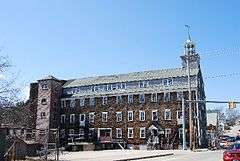Christopher Lippitt
| Christopher Lippitt | |
|---|---|
| Born |
October 28, 1744 Cranston, Rhode Island |
| Died | June 17, 1824 (aged 79) |
| Known for | American Revolutionary officer; founded Lippitt Mill |
| Religion | Methodist |
| Spouse(s) | Waite Harris |
Christopher Lippitt (October 28, 1744 – June 17, 1824)[1] was a prominent Revolutionary War officer and founder one of the earliest textile mills in Rhode Island.
Early life
Lippitt was the fourth child of Christopher Lippitt (1712–1764) and Catherine (Holden) Lippitt and the oldest surviving son at the time of his father's death in 1764. Since 1715 the Lippitt family had owned Lippitt Hill in the Hope neighborhood in the southwestern part of Cranston, Rhode Island. Lippitt was first elected to General Assembly at age 21 and continued serving until Revolution. At age 22 made captain of militia and Justice of the Peace.[2] Lippitt owned a sawmill and a farm and was recorded as having six slaves in the 1774 census and two slaves in 1790 census.[3][4]
Service in Revolution
At the outbreak of the American Revolution in 1775, Lippitt was chosen Lieutenant Colonel of the Rhode Island regiment and of the minutemen, which defended Prudence Island from British warships. In 1776, his regiment joined the Continental Army on George Washington's orders and went to Harlem Heights, New York. Lippitt commanded a regiment at the Battle of Princeton, Battle of White Plains and Battle of Trenton. He was eventually brevetted a brigadier general of the Continental Army by General Washington for his actions on the battlefield. He spent the winter at Morristown and returned to Rhode Island in the spring when the regiment's tour of duty expired. Upon returning to Rhode Island, Lippitt was promoted to the rank of brigadier general of Rhode Island militia in 1780, and commanded a brigade when the French troops occupied Newport. He served as a general until 1783.[2]
After the Revolution

After the Revolution Christopher Lippitt returned to farming for a period and was elected to the Rhode Island General Assembly and was appointed justice of the Rhode Island Supreme Court. In the 1780s, Lippitt was dismissed from political office by voters for supporting adoption of the U.S. Constitution which was unpopular in Rhode Island at the time.[5]
Christopher Lippitt was an active Christian and was a member of the local Methodist congregation. Lippit was raised by his mother as an Episcopalian. He was introduced to the Methodists by his brother Charles, while serving in New York during the Revolutionary War. In 1791 Christopher Lippitt invited Jesse Lee, a prominent Methodist evangelist, to preach and teach a class at his house. Lippit's wife and daughter became Methodists at this time. In 1800 Lippitt built a small meeting house on his farm to serve as a Methodist chapel.[6] Prior to this he had offered his home for use by itinerant Methodist preachers. Later in life Lippitt joined the Peace Society.[2]
In 1805, Lippitt built the house still known today as Lippitt Hill Farm in Cranston.
In 1809, Christopher and his younger brother, Charles Lippitt, along with Benjamin Aborn, George Jackson, Amasa Mason, and William Mason organized a cotton mill under the name the Lippitt Manufacturing Company.[7] The company grew throughout the 19th century becoming a large profitable enterprise in which several generations of the family were involved. The original Lippitt Mill building still stands in Lippitt Village in what is now West Warwick.[8]
Family
Christopher married Waity (or Waite) Harris (1755–1836) in 1777, and had the following children:
- 1. Susanna (1778–1818)
- 2. son (1779-1779)
- 3. son (1781-1781)
- 4. son (1782-1782)
- 5. Christopher Jr. (1783- )
- 6. Waity (1784- )
- 7. daughter (1785-1785)
- 8. William (1786–1872)
- 9. Joseph (1790- ), settled in Ohio.
- 10. son (1793-1793)
- 11. Mary (1795- )
- 12. Benjamin (1797–1803)
Notable Lippitt family members
- Charles W. Lippitt, governor of RI
- Henry Lippitt, governor of RI
- Henry F. Lippitt, U.S. Senator
- John Chafee, U.S. Senator, Governor of RI
- Lincoln Chafee, U.S. Senator, Governor-elect of RI
References
- ↑ Americans of Royal Descent: Collection of Genealogies Showing the Lineal Descent from Kings of Some American Families. Genealogical Publishing Com. 1911. p. 17. Retrieved 8 May 2015.
- 1 2 3 James N. Arnold, The Narragansett Historical Register (Heritage Books, 1998), pg. 111-113 https://books.google.com/books?id=CuuicaMM3KEC&source=gbs_navlinks_s
- ↑ 1774 Rhode Island Census (republished in 1858) https://books.google.com/books?id=oc_-CMySsLIC&source=gbs_navlinks_s
- ↑ http://www.rootsweb.ancestry.com/~rigenweb/census/1790pg26.jpg/
- ↑ Lineage book - National Society of the Daughters of the American Revolution, Volume 4 (Daughters of the American Revolution, 1897), pg. 11 https://books.google.com/books?id=LWYZAQAAIAAJ&source=gbs_navlinks_s
- ↑ A history of the Episcopal Church in Narragansett, Rhode Island: including a history of other Episcopal churches in the state, Volume 2 (DB Updike, 1907)pg. 392 https://books.google.com/books?id=wczOQRy1aB4C&source=gbs_navlinks_s
- ↑ Lippitt Manufacturing Company founding agreement http://www.yankeeattic.com/RARE-Lippitt-Manufacturing-Company-in-West-Warwick-Rhode-Island-now-Lippitt-Mill-Revolutionary-WAR-veteran-Christopher-Lippitt/
- ↑ "Lippitt Family papers at RI Historical Society". rihs.org.